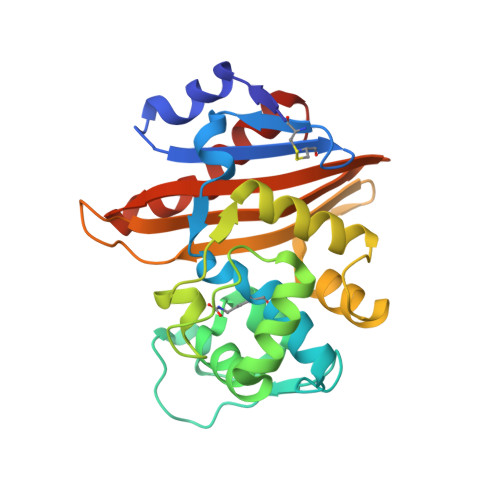Critical involvement of a carbamylated lysine in catalytic function of class D beta-lactamases.
Golemi, D., Maveyraud, L., Vakulenko, S., Samama, J.P., Mobashery, S.(2001) Proc Natl Acad Sci U S A 98: 14280-14285
- PubMed: 11724923
- DOI: https://doi.org/10.1073/pnas.241442898
- Primary Citation of Related Structures:
1K54, 1K55, 1K56, 1K57 - PubMed Abstract:
beta-Lactamases are the resistance enzymes for beta-lactam antibiotics, of which four classes are known. beta-lactamases hydrolyze the beta-lactam moieties of these antibiotics, rendering them inactive. It is shown herein that the class D OXA-10 beta-lactamase depends critically on an unusual carbamylated lysine as the basic residue for both the enzyme acylation and deacylation steps of catalysis. The formation of carbamylated lysine is reversible. Evidence is presented that this enzyme is dimeric and carbamylated in living bacteria. High-resolution x-ray structures for the native enzyme were determined at pH values of 6.0, 6.5, 7.5, and 8.5. Two dimers are present per asymmetric unit. One monomer in each dimer was carbamylated at pH 6.0, whereas all four monomers were fully carbamylated at pH 8.5. At the intermediate pH values, one monomer of each dimer was carbamylated, and the other showed a mixture of carbamylated and non-carbamylated lysines. It would appear that, as the pH increased for the sample, additional lysines were "titrated" by carbamylation. A handful of carbamylated lysines are known from protein crystallographic data, all of which have been attributed roles in structural stabilization (mostly as metal ligands) of the proteins. This paper reports a previously unrecognized role for a noncoordinated carbamylate lysine as a basic residue involved in mechanistic reactions of an enzyme, which indicates another means for expansion of the catalytic capabilities of the amino acids in nature beyond the 20 common amino acids in development of biological catalysts.
- Groupe de Cristallographie Biologique, Institut de Pharmacologie et de Biologie Structurale du Centre National de la Recherche Scientifique, 205 Route de Narbonne, 31077-Toulouse Cedex, France.
Organizational Affiliation:



















